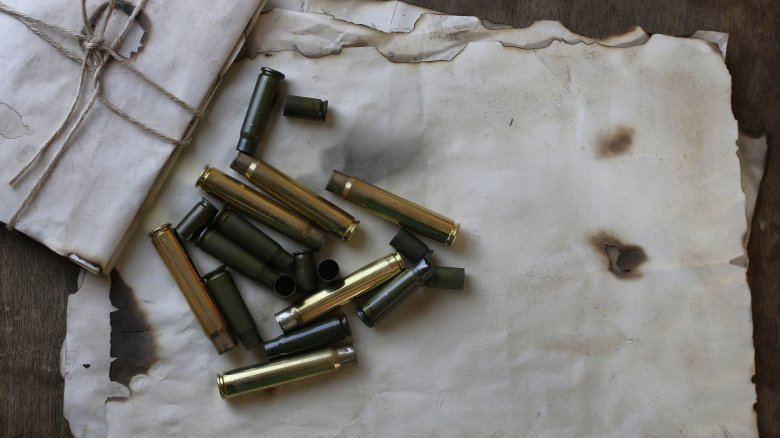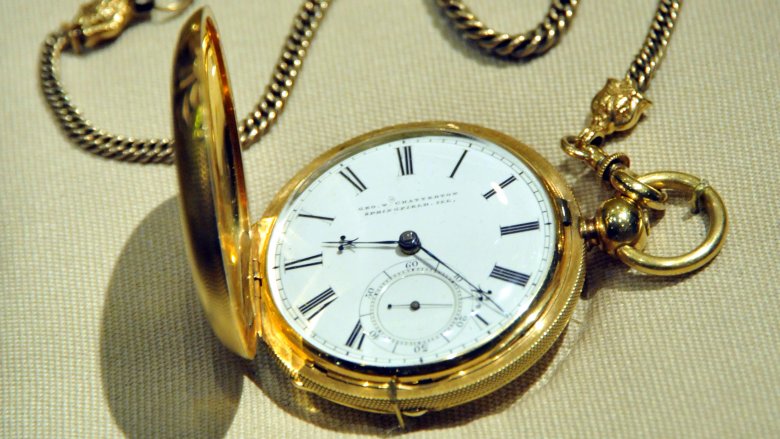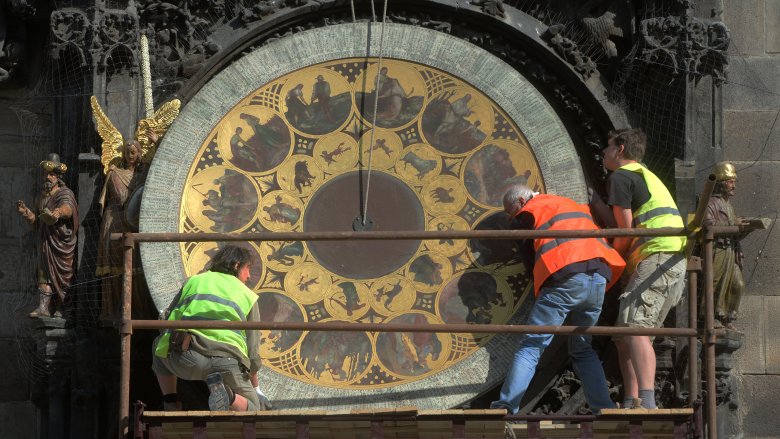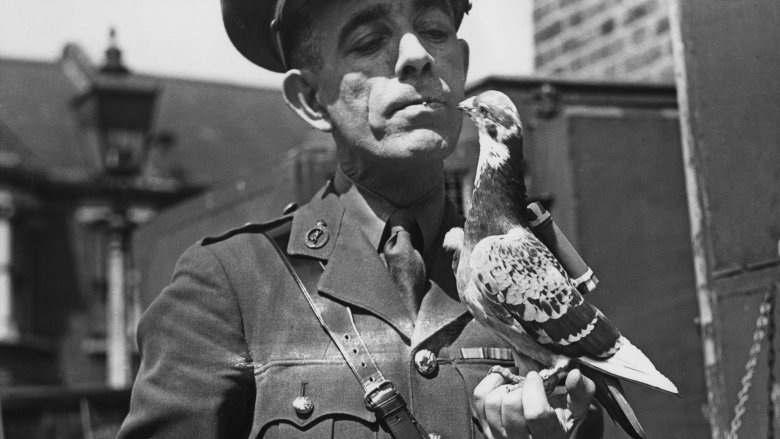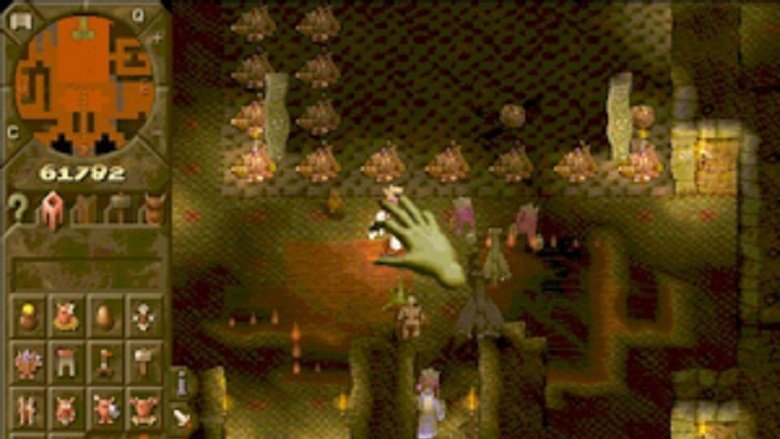Secret Messages We Discovered Years Later
There's something magical about getting a secret message from the past. It's people reaching through time to give information to those who haven't even been born yet, letting them know something they think is important enough to record. Sure, there are obvious ways to do it, like through books or recordings or official time capsules, but that's boring. What's really cool is when the message is hidden and unexpected, only stumbled upon accidentally years later.
It doesn't happen all that often, but sometimes a note from the past is discovered in the most unlikely place. Many times it's related to war, since conflict necessitates the sending of secret messages, often in code. Other times it's completely random, with people hiding notes in statues, behind walls, even in video games. Since no one knew they were there, these secret messages could have stayed hidden forever. It's only by accident they were found, so keep your eyes peeled for the unofficial kind of time capsule. One could be anywhere.
A World War I seamstress sent a secret message in search of a husband
It must've been difficult being a young single woman looking for love during World War I. There you were, ready to get married, and all your potential suitors were suddenly off fighting in Europe. The only guys still around would be unfit for duty, so unless you were willing to settle for some really old dude or a coward with bone spurs, you just had to wait until the Hun was defeated.
One Scottish seamstress wasn't having that. She decided to use her job to make her own personal World War I version of Tinder. According to the Telegraph, in 2014, economic historian Dr. Helen Paul revealed that when she had removed the packing stitches from the folds of a kilt that had been passed down in her family for decades, a piece of paper fell out. The kilt had originally been destined for a soldier at the front, and seamstress Helen Govan apparently knew that while she was making it. So she included the message, "I hope your kilt will fit you well, & in it you will look a swell. If married never mind. If single drop a line. Wish you bags of luck, & a speedy return back to Blighty," along with her name and address.
Sadly for the poor spinster Helen, the kilt was never unpacked or worn for reasons that are unclear. Hopefully she managed to find love anyway. Dr. Paul was hoping to hear from the seamstress' descendants, so if your great-grandma Helen was really into military guys, get in contact.
A secret message explaining a key German weakness
Americans often think of Europeans as very suave. But there are geeky ones, too, like the people who wander around fields with metal detectors. When two major wars were fought on your soil in the last century, there's plenty of metal stuff to find.
In 2015, in Tuscany, a group of detectorists found a bullet, according to posts on an Italian metal detector forum (via Gizmodo). Nothing unusual there. But this one was inverted into its case, so something was obviously up. They opened it and found a coded secret message inside. Apparently, this was a standard way of hiding notes during the war, since you could just chuck the bullet away and it wouldn't be noticed among the other ammunition on a battlefield.
A poster on another forum got out his grandfather's code books and claimed to work out the message. Supposedly, it says "THEY – THROW – GRENADES – WE – PULL – PINS – AND – THROW – BACK – NOTIFY REINFORCEMENTS STAND DOWN – NOT NEEDED." It's an odd message, but the explanation is even weirder. Some Italian grenades had two pins, and soldiers needed to pull both to make them live. It appears German soldiers were unaware of this, and were pulling just one pin, then throwing the unprimed grenades at American troops, who pulled the second pin and then threw them back. The Americans wrote they didn't need reinforcements because the enemy was helpfully supplying free grenades and they were in absolutely no danger.
A secret message that insulted a homeowner's taste
Tastes change, we all know that. Today's granite countertops and fancy backsplashes are tomorrow's ground glass and holograms, probably. Still, it's annoying to think when you are spending so much money and putting in so much effort to redecorate a room that the next family is going to come along and rip it all out while tutting about your obsession with the color eggshell.
One couple decided they were going to make any redecorators feel guilty. In 2018, Today reported that Alex and Jessica Monney were redoing the bathroom in their California home when the contractor working on it sent them a picture. Behind a wall he'd found a photo of the previous homeowners along with the message, "Hi! We're the Shinsekis!" it said. "We remodeled this bathroom Summer 1995. If you are reading this, that means you're remodeling the bathroom again. What's wrong with the way we did it?!?!?" They were not the only occupants of the house at the time, as there was also a picture of a black and white bunny that left its own message: "Hi! I'm Cassie the Bunny Rabbit. I lived here too! (I'm potty trained!) I'm going to be the next Cadbury Bunny."
When they shared the messages on Twitter, the search was on for the Shinseki family. One man with the same last name claimed it was his little brother but didn't elaborate. Regardless, the Monneys said they were definitely going to add to the message for the next renovators to find.
A man who found an 88-year-old secret message from his grandfather
When you are still using churches from the 12th century, they're going to need work from time to time. So it was with the cathedral in Goslar, Germany. The Washington Post reports that in 2018, roofer Peter Brandt was doing some maintenance when he found a secret message in a bottle hidden under the eaves. It had been put there 88 years before and was signed by Peter's own grandfather, Willi Brandt.
In 1930, Willi was just an 18-year-old roofing apprentice. He and the other guys working on the church roof back then decided to write a note to the future. They talked about how hard things were economically, recording they "worked an entire week for 1 pound of butter and 1 bread." But they had faith things were going to get better, writing, "Difficult times of war lie behind us. We hope for better times soon to come." Since it was 1930, their hopes would obviously not be realized.
Willi would enlist as a soldier in World War II and was captured by the Russians. Peter said when he knew him, his grandfather would never talk about the war and never mentioned leaving the note, even as Peter learned all about being a roofer from him. The original secret message was added to the town archives, but a copy (with an additional note from the current mayor) was put back in the bottle and placed under the cathedral's roof again. It's hoped it will be found by roofers in another 100 years.
Lincoln's watchmaker was only a little bit full of it
When you live through a major event you know will be historically significant, it makes sense you'd want to commemorate it. And watchmaker Jonathan Dillon had a bigger opportunity than most on April 13, 1861, according to Smithsonian Magazine. The Irish immigrant was in the middle of repairing the pocketwatch of President Abraham Lincoln himself when Fort Sumter was attacked, starting the Civil War.
Forty-five years later, Dillon told the New York Times that when he heard the news he had taken the dial off the watch and scratched a secret message to Lincoln underneath. It was a beautiful, soaring message of hope that Lincoln would unknowingly carry around with him during the war: "The first gun is fired. Slavery is dead. Thank God we have a President who at least will try."
At least, that's what Dillon said he wrote, almost half a century later, with plenty of hindsight. For 150 years, no one knew if there was a message at all because no one had ever opened the pocketwatch. But the National Museum of American History finally did in 2009, with 40 reporters watching on. Inside they found the message: "Jonathan Dillon April 13-1861 Fort Sumpter [sic] was attacked by the rebels on the above date J Dillon April 13-1861 Washington thank God we have a government Jonth Dillon." So he wasn't completely full of it, but the note was nowhere near as meaningful and forward-thinking as Dillon remembered it later, and he egotistically included his own name three times.
A priest hid a secret message in Jesus' butt
People have made time capsules out of plenty of weird things, but Jesus' butt must be up there for one of the strangest. National Geographic reports in 2017 Spanish historians were restoring a statue of Jesus from the 18th century. The figure of Jesus being crucified was starting to crack and coming loose from the cross, so they took it down, and while putting it on a worktable they realized there was something inside. After removing the Lord's carved wooden loincloth, they found a hollow bottom with two hidden letters. The documents turned out to be from 1777, written by a chaplain named Joaquín Mínguez.
Mínguez certainly liked the sound of his own voice, so to speak. His letters were incredibly detailed. They recorded who made the statue and other work the artist had done for various churches in the area. He then described how well different harvests went for "wheat, rye, oats, and barley and stores of wine." But not everyone was happy and well fed, since Mínguez named all the diseases plaguing the village, like typhoid fever. He recorded that the people who were not busy dying were having fun playing games like cards and balls. Then he moved onto national news, talking about King Carlos III and his court in Madrid, plus the Spanish Inquisition, which would last another 57 years.
According to one historian, the amount of detail in the letters probably meant Mínguez intended them to be "a kind of time capsule for future generations."
The Astronomical Clock is full of secret messages
Prague's famous Astronomical Clock has plenty of places to hide a secret message. According to Prague.TV, the 15th-century clock was undergoing maintenance in 2018. This was not surprising, since it's the oldest astronomical clock still working and also needed alterations or repairs in 1490, 1552, 1791, 1861, and 1912. But in 2018, restorers realized one of the statues of the Apostles weighed more than the others. They X-rayed St. Thomas and discovered a metal cage inside. When they removed it, they found it contained a note from the past.
In 1948, the clock had undergone yet more repairs. To be fair, it really needed them, since some of the sculptures were destroyed in a fire during the Prague Uprising at the end of World War II. Vojtěch Sucharda was in charge of recreating them. Apparently, he decided to leave a message to the future in one of them. The sculptor praised "the beauty of the Astronomical Clock and its historical value" and also described "his more extensive plans" for changes to the clock, but the plans never ended up happening. It wasn't all about art, though: Sucharda also complained about the conditions in 1948, specifically the beginning of communism in Czechoslovakia.
A city councilor said the 70-year-old note showed the monument was still full of surprises, and it wasn't the only thing restorers found. They also discovered previously hidden stone carvings of animals. Sadly, rumors of a secret room in the building housing the clock turned out to be untrue.
A World War II carrier pigeon took its secret message to the grave
Humans aren't the only victims of war. The New York Times reports that in 1944, a carrier pigeon code named 40TW194 was carrying an encrypted message from France when something went wrong and it ended up dying in the chimney of a house in Bletchingley, England. There the pigeon and its message stayed until 1982, when homeowner David Martin was cleaning it out and found the skeleton with the note attached.
In 2012, after "sustained pressure from pigeon fanciers," Britain's current code-breaking unit agreed to try and figure out what the message said. They didn't dedicate crazy amounts of time to it, obviously, since they have more pressing things to work on, but after a month they said they couldn't figure it out. A historian said of the code, "If it's only used once and it's properly random, and it's properly guarded by the sender and the recipient, it's unbreakable." Even if it was based on a more regular code, it was "unlikely" to be cracked, since the whole point was for the encryption to be ridiculously hard to break.
That didn't stop one Spaniard who heard about the pigeon and its message. According to the Telegraph, in 2015, Didac Sánchez claimed he had figured it out after three years of being obsessed. He read up on wartime encryption, put together a team of "top computer scientists," and spent €1.5 million on the effort. Then he refused to tell anyone what the secret message said, so who knows if he really succeeded.
The makers of Dungeon Keeper were so very tired
Making a video game can be exhausting. Even today, with hundreds of people and millions of dollars behind major releases, teams often work themselves into the ground. In the '90s, it was an even bigger labor of love.
That's evident in the secret message designer Jonty Barnes hid in 1997's Dungeon Keeper, according to Polygon. Despite the 100 people credited as working on the game, Barnes says 95% of it was completed by seven people above a garage. It took everything out of them. So, at 4 a.m. one day, not long before the master of the game was sent off, Barnes added these lines to the executable file:
"I look around the office ... All I see are the tired pale faces of the [Dungeon] Keeper team. After sixteen hours a day, 7 days a week, for nearly 5 months ... this game has been written with a passion I am proud to be a part of. I do not just hope you like it, I also hope you are aware of the huge amount of work we have all done. Sleep is due to me ... And I have a dream to live."
It seems no one found the message for 17 years. Then in 2014, GOG.com uncovered it and Barnes confirmed on Twitter that he remembered writing it but hadn't seen it since. He had gone on to make more games that had also "taken absolutely everything [he had] to give." Hopefully, he also got sleep at some point.
Ireland didn't want to get involved in World War II
In 2018, the effects of a drought and heat wave uncovered a whole bunch of cool stuff in Ireland. According to History, there was "the discovery of the supposed home of St. Oliver Plunkett, a Roman Catholic martyr, and the discovery via drone of an ancient henge dating to 3,500 B.C.E." And then there was the wildfire that burned away undergrowth to reveal a giant World War II-era carving on the coastal cliffs, partially eroded at that point, that said "ÉIRE" (meaning "Ireland" in the Irish Gaelic language). There were originally over 80 of those signs, but this one had been forgotten about. The idea behind it was to let German bombers know they were flying over neutral land and not to attack.
Yeah, about that. Ireland didn't officially side with the Allies during World War II, basically because they hated Great Britain more than the Nazis. Before the war started, the country said it wouldn't join any conflict the U.K. was fighting in, so they stayed neutral. That was the official line. Unofficially, they knew which side were the good guys and helped them out. Around 43,000 Irish people enlisted in the British armed forces. The Irish government gave the Allies information about German planes and submarines off Ireland's coast, while also letting Britain use its airspace. When German troops ended up in Ireland they were detained, while Allies were allowed to return to the U.K.
And the carved signs didn't stop all attacks. In 1941, the German Luftwaffe bombed Belfast, killing over 1,000 people.


